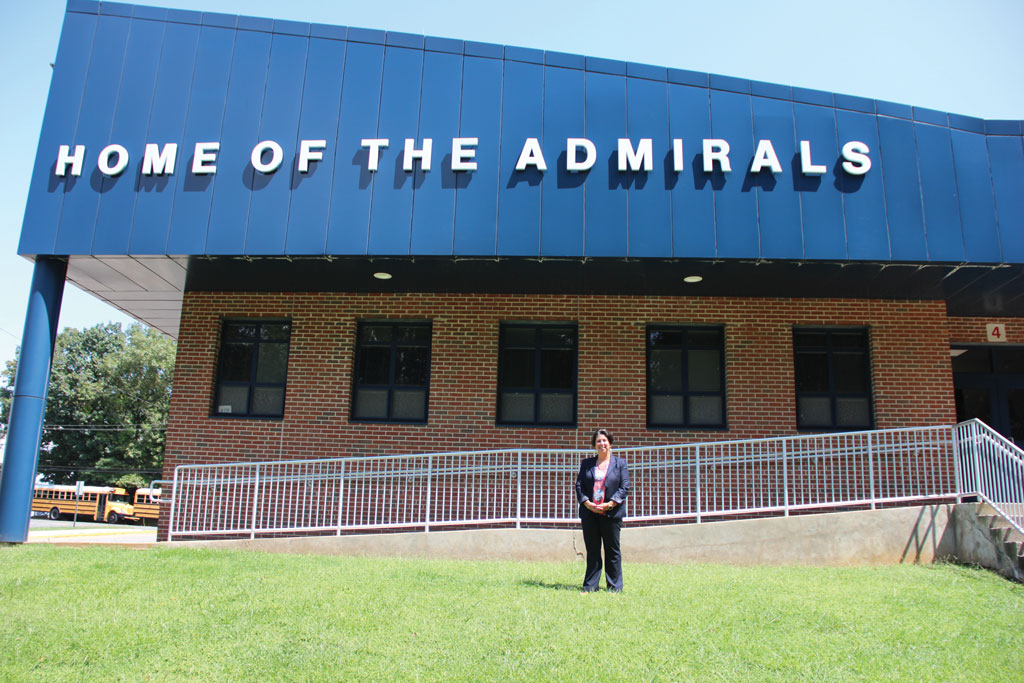On July 1, 2024, a message that was decades in the making was delivered to the residents of Highlands and Atlantic Highlands via a letter on board of education letterhead: Welcome to the Henry Hudson Regional PK-12 School District!
Several months earlier – in a special school election in September 2023 – voters approved joining together the boards of education of the Highlands School District, Atlantic Highlands School District and Henry Hudson Regional School District to convert Henry Hudson Regional (which serves grades 7-12) into an all-purpose PK-12 regional school district.
The vote followed historic legislation that Gov. Phil Murphy signed in January 2022 – S-3488 – which provides school districts with incentives to study regionalization.
Under the new law, school districts that commission a feasibility study on regionalization will immediately be reimbursed for half the cost of conducting a study, and they will be reimbursed for the second half once it is accepted by the New Jersey Department of Education.
The legislation specifically states that a school district can conduct a feasibility study but not be obliged to move forward with a push toward regionalization. Furthermore, if a study finds that a regionalization would cost the taxpayers money, create inefficiencies or somehow enhance segregation, then it cannot move forward. Moreover, it lays out some parameters of how a regionalization should proceed, including guidance on bargaining, salary guides and forming a new board of education.

In January 2022, Henry Hudson Regional teamed up with The Busch Law Group for legal analysis, Ross Haber Associations on a demographic study, SSP architects for a facilities/physical plant analysis and Kean University on an education assessment and educational finance analysis to carry out such a feasibility study on forming a new, all-purpose PreK-12 school district that would include Atlantic Highlands Elementary, Highlands Elementary and Henry Hudson Regional – and studying the possibility of including additional districts in the geographic area.
That move came after the school received a $65,000 implementation grant, which was announced by the Murphy administration and the Department of Community Affairs on May 11, 2021.
The First in a Long Time According to the New Jersey League of Municipalities, there are 564 municipalities in the state.
That may seem like a lot, but it’s fewer than the state’s 583 school districts. For decades, the state has encouraged school districts to explore regionalization, not only to ease the burden on taxpayers, who pay the highest property taxes in the nation, but also to enhance student achievement.
Despite those efforts, however, before Henry Hudson, the last regionalization occurred in 2013, when Hunterdon County voters approved merging four school districts into the South Hunterdon Regional School District.
While numerous school districts have conducted feasibility studies – and while several have given voters the chance to decide the matter – Henry Hudson has been the only one to move forward with regionalization. (In September 2024, after the Henry Hudson Regional School District was formed, voters approved the Stow Creek School District Board of Education and the Greenwich Township School District Board of Education joining together to form the limited-purpose PK-8 Greenwich-Stow Creek Regional School District.)
Dr. Tara Beams, who was previously the shared superintendent of Atlantic Highlands Elementary School, Highlands Elementary School and Henry Hudson Regional School, now heads the regional school district. The new legislation definitely made the process easier to navigate, she said.
Jonathan Busch, founder of the Busch Law Group, which represented the districts throughout the process, noted, however, that it also raised some questions.
“There are a number of inconsistencies in the statute and precious little guidance from the state as to what was expected from us to resolve those inconsistencies,” he said. “And you get asked by your client, ‘What do we do here?’ You are all reading the same statute, and there are no examples to use. So, sometimes the answer is, ‘I am not sure, and no one really knows what the answer is, but we are going to try this.’”
Eyes Wide Open When Beams began her work as superintendent in July 2021, she knew that regionalization was a distinct possibility upon taking the job.
“Regionalization had been discussed for more than 45 years in these communities,” she said. “I knew at the time that the districts had gone through somewhat of a contentious dialogue with the municipalities leading up to this phase.”
The schools had worked closely together for some time, Beams said, with a shared services agreement being implemented in 2006. “Most of that was around personnel. And our curriculum has been aligned in our elementary schools since 2006. There has been a lot of sharing of resources,” she said, which has included a shared superintendent since 2011. In 2014, the boards of education adopted the “Tri-District” name to recognize the special relationship between the three schools, Beams said.
While previous studies on regionalization had been conducted, the idea gained momentum when Henry Hudson, Highlands Elementary and Atlantic Highlands Elementary banded together to commission a study of their own. “There have been a number of studies conducted over many years,” she said, noting that Sea Bright, which the schools considered including in its regionalization, commissioned a similar study that was published in March 2020.
“The districts had some concerns with the information in that study and decided to conduct their own feasibility study,” Beams said. “So, they applied for the grant to complete a feasibility study prior to the passing of the legislation.”
During the pandemic, however, regionalization became “the last thing that anyone talked about,” she said.
But with the findings of the new feasibility study along with the passage of the legislation on regionalization, various questions were answered.
Specifically, the legislation states, “The salary guide and terms and conditions of employment whether established through a collective negotiations agreement or past practice, of the largest constituent school district shall apply in full after three years following the formation of the regional school district or until a successor agreement is negotiated with the majority representative of the new school district, whichever is first.” It goes on to provide additional instructions surrounding employment and bargaining.
“Those types of questions were kind of easily answered,” Beams said. “The other thing is that we knew we had been operating in this Tri-District structure. It was not like we were losing or gaining students.”
There were some prospects on the horizon that were not as comfortable for staff, such as the idea of involuntary transfers. For others, however, who may have wanted to teach at one of the neighboring schools, the prospect of being able to request a transfer was a plus.
Other concerns turned out not to be concerns at all.
“It’s not as though an Atlantic Highlands teacher needs to learn a new curriculum … we just do not have those barriers that would impact staff,” Beams said. “We do not have anything related to inequities … it was all about the operational and governance structures.”
As a result of the regionalization, a part-time business administrator, one administrative assistant to that business administrator and a part-time teaching job in the arts had to be eliminated, Beams said.
“But with our preschool program at Atlantic Highlands, we have opened up additional positions,” she said. “And our ESL population is exploding.”
Throughout the process, Beams strived to show everyone why regionalization might make sense. “There is a lot you gain in terms of productivity and efficiency when you are not having to do things three times,” she said.
Approving the PlanAbout 65% of votes were cast in favor of regionalization. For a special election with nothing else on the ballot, turnout was good, Beams said.
Preparing for the referendum, however, was no easy task, Beams said.
“We held what we called an information fair, and we invited community members to come,” she said. Board members spoke along with others, including a consultant and the board attorney. “We had various experts, so if someone had a question about taxation or legal ramifications, our entire administrative team was there.”
Board members also visited residents and tried to clear up misinformation, Beams said. “There was a real grass-roots campaign,” she said.
Cory Wingerter, formerly of the Atlantic Highlands Elementary School Board of Education and now the president of the Henry Hudson Regional School District’s transitional board of education, said there was a team of people who were not board members who were instrumental in getting information out to the community. “I think it was important to have supporters of regionalization get information out to the public – factual data that was presented in an easily digestible manner that anyone could look at,” he said.
There were also information sessions held at Back-to-School nights – and it was a topic of discussion at every board meeting, Beams noted.
“We wanted to hear from the people on the ground and to be very honest about why we felt this was good for our communities and why we felt this was good for our students, which was most important,” Beams said, observing that for too many people, regionalization has devolved into a conversation that focuses solely on taxes.
Taxes, however, really should be just one concern, Beams said. There are larger questions, such as what’s best for students, will schools run more efficiently under a regionalized system, and will a regionalized school district be more sustainable for the future, she said.
With the regionalization now a reality, Beams is looking forward to taking advantage of some of the efficiencies district leaders foresaw as they studied the idea.
From Three Boards to Four – to OneWhen the new district was “turned on” July 1, 2024, there was no big celebration – just an email sent out to stakeholders welcoming them to the new district, Beams said.
One of the most challenging aspects of regionalizing was taking three boards of education and creating a fourth one to manage the newly created district. The legislation details how to go from multiple boards to one.
“I had 25 individual board members sitting on three different boards of education,” Beams said. “They all put children first and were not worried about political agendas.”
Board members took a careful look at what regionalization meant from an operating and governance standpoint, Beams said. They did not let whether they wanted to continue being a board member or concerns about “home rule” get in the way of what was best for students, she said.
Once the schools knew they were going to regionalize, they had to create a transitional board, which is derived from a formula, Beams said. “In our case, it was a third, a third and a third – and five members had to come from Highlands and four members from Atlantic Highlands based on our census. That is how our regional school board is constructed – there has to be a certain percentage of constituent members,” she said.
In November 2024, all nine seats on the board will be up for election, consisting of three three-year terms, three two-year terms and three one-year terms. Five of the elected members will come from Highlands and four from Atlantic Highlands.
For a time, there were four board of education meetings being held, which was a struggle, Wingerter said. The transitional board would meet prior to an elementary school board of education meeting, “so some people were pulling double duty on Wednesday night,” he said. “We are very excited to now have it down to one board.”
As far as the process of choosing the members of the transitional board, members of each of the existing boards worked together to pick appointees. “A few members very much wanted regionalization to happen, and they wanted to see their way through,” Wingerter said. “Others were excited to be part of something new – there was a good mix, across the board.”
A regionalized district will provide the best experience for students, he said. “They may not notice it day to day … but now we can put our focus back on the administration, curriculum, testing and scoring. This was the right thing to do,” he said.
Busch, whose law firm represented the districts throughout the process, said going from 25 school board members (across three boards) to nine members on one school board was “a great example of unselfish government – board members doing what they believe is right even if it potentially came at their own expense.”
Sea Bright Woven into all this was the question of whether Sea Bright, which has expressed interest in being part of the new district, should be included. Currently, students from the Borough of Sea Bright attend pre-K through eighth grade in Oceanport and high school at Shore Regional High School.
Atlantic Highlands, Highlands and Henry Hudson, however, decided to move forward independently as Shore Regional and Oceanport mounted legal opposition to Sea Bright’s efforts to withdraw from either.
“Sea Bright has a very complicated structure because they do not have a board of education – they send their students to two different districts: Shore Regional and Oceanport,” Beams explained.
The original petition that the districts sent to the acting commissioner of education included Sea Bright, Busch said.
The acting commissioner at that time, however, never ruled on the matter, he said. “We waited and waited … and with no end to the wait in sight, the boards finally got together and said if Sea Bright is the problem, why don’t we get together and do this ourselves,” he said.
Even though the acting commissioner never responded to the initial petition, Oceanport and Shore Regional sued the municipalities and school boards after it was filed, Busch said. Later, another lawsuit was filed by Jo-Anne Olszewski, president of the Highlands Council, in a bid to stop the Atlantic Highlands, Highlands and Henry Hudson Regional school boards from settling the matter and moving forward without Sea Bright.
The acting commissioner approved the petition that did not include Sea Bright in July 2023, which paved the way for voters to decide the issue.
Still, that did not prevent some citizens from balking at the proposal, Busch said. “There had been a mentality from some that there was a silver economic bullet in having Sea Bright join Henry Hudson,” he said. “This fallacy of ‘Why don’t you regionalize with Sea Bright?’ became a rallying cry, particularly among municipal officials in Highlands and Sea Bright, who were concerned they might only get one bite at the apple. But the truth is, the commissioner of education did not appear willing to allow Sea Bright to regionalize at the expense of Oceanport and Shore Regional.”
While Henry Hudson Regional School District is open to the idea of Sea Bright one day joining, it does not want to get embroiled in more litigation, Beams said.
“The mantra has always been, ‘Figure out a way to get divorced and then we can talk about getting married,’” Beams said. “It is a very complex issue. And we were able to move forward with our referendum once we removed that complex issue.”
Busch agreed, noting, “The districts have always said they would entertain the possibility of Sea Bright as part of the Henry Hudson Regional School District, but we are not going to continue to fiddle in the ongoing relationship Sea Bright has with Oceanport and Shore Regional at the expense to taxpayers and our responsibility to current students,” he said.
The entire ordeal is a “microcosm of the problems we are seeing across New Jersey,” Busch said. “As we discuss ways to make government more efficient, you run into things and issues that you could never possibly imagine,” he observed.
Setting a Path ForwardOnce voters approved the regionalization, there were plenty of questions about how to proceed.
“We were the first to do this under this new legislation, which was an untested law,” Beams said. “It was very cumbersome. There is a lot in the legislation that no one had ever done before … and there are also some very strict time constraints as to when things need to take place.”
Namely, a regionalized school district had to be created for the opening of the 2024-2025 school year, which meant by July 1.
“Our technology platforms had to merge together, shifting everyone in the pension system and health benefits – there was a lot of behind-the-scenes work that we could not anticipate until we were actually doing the work,” Beams said. Some questions had easy solutions – others not so much, she said.
While staff at the New Jersey Department of Education had helped regionalize school districts before, this was their first time going through the process under the new law, Beams noted. “So, there were a lot of gray areas in terms of interpretations of the law that had not been tested,” she said. “How are you applying this? What does this mean theoretically as opposed to practically? Answering those questions has been really difficult.”
One thing is clear to Beams, however: The next schools to embark on a regionalization will be able to look to Henry Hudson Regional to answer questions on everything from how to merge accounting systems to how to adapt as a newly created district seeking state and federal funds and all sorts of questions in between.
“We are comfortable being the guinea pigs in all this,” Beams said. “We know this is important for our communities, and we are willing to work through it. The questions are being answered, and the anxiety of having to meet that July 1 date pushed us.”
When the dust settled, the schools met the July 1 deadline.
“We are now a fully comprehensive preK-12 school district – everything is done, and everything is moved,” Beams declared. “Now, we are in the process of figuring out what does that look like?”
At some point – not for the 2024-2025 school year but perhaps in the not-too-distant future – the district may turn Henry Hudson from a grade 7-to-12 school into a grade 6-to-12 school, Beams said.
“That has been discussed for a while,” she said, noting that such a change would have previously been more complicated as it would have entailed send and receive relationships. “Regionalization has opened up that path to revisit that,” she said.
From an academic standpoint, curriculum is usually designed for K through 5, grades 6 to 8 and grades 9 to 12, Beams said. “Sixth grade is an outlier,” she said, adding that there could be some social and emotional benefits to including sixth graders at Henry Hudson and easing that transition to high school.
One question the new district is still navigating revolves around state aid.
“Two of the three previous districts – Henry Hudson and Highlands – were both S-2 districts that have been losing funding – they have lost a little over $750,000 combined since S-2,” Beams said. “It has hit Highlands really hard.”
When Beams spoke to School Leader in July, she noted that state aid had gone up by about $52,000 compared with what it would have received if it were still three separate districts, but the district is contesting that number as it believes it’s eligible to receive more. Talks over how much state aid it will receive were ongoing, she said.
Advice for Other Districts More districts would be wise to look at regionalization, Beams said, who noted that some face declining enrollments.
“My mandate is the same mandate as Middletown next door to me, which is one of the largest municipalities in Monmouth County,” she said. “Smaller districts do not get to scale down what they need to implement or do for students.”
She advised smaller districts to take a look at their neighbors, who may be struggling with the same challenges. “The hard part is when you are just sharing human beings and don’t have a shared operational or governance structure,” she said. “If shared services are going to be about personnel, you need to ask how your operational and governance structure supports that model.”
Assuming communities can “tear back some of the emotional responses to regionalization” and focus on the practical solutions it may offer, it’s worth exploring, she said. “Exploring it does not mean you need to jump in,” she said.
With the new school year arriving, Beams and her team have been keeping their heads down and “focusing on our kids,” she said. She’s happy to be able to look at her job as superintendent through a new lens.
“For my entire tenure here – the first three years – board members have told me that I have been the superintendent of regionalization. Now, they want me to be the superintendent of schools,” she said.
Thomas A. Parmalee is NJSBA’s manager of communications and publications.




